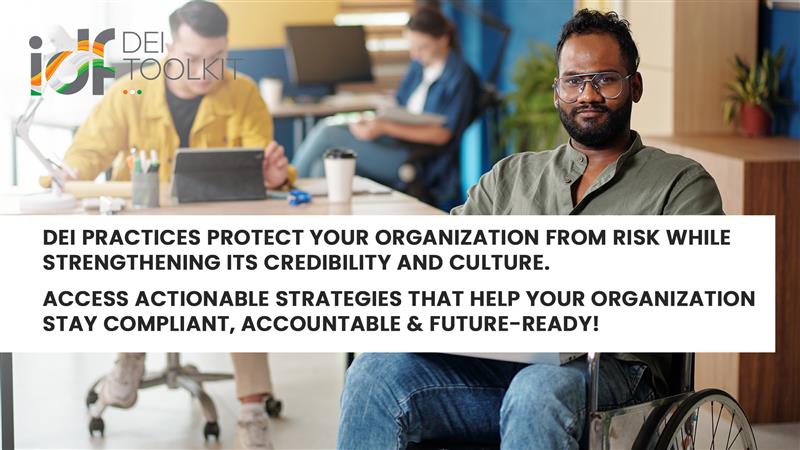In today’s business environment, diversity, equity and inclusion (DEI) have moved far beyond being moral or ethical initiatives. They have become essential frameworks for risk management, trust building and long-term resilience. Organizations that treat DEI as a strategic imperative, rather than a compliance afterthought, are better positioned to avoid legal liabilities and protect their reputational capital. At the same time, those that retreat from inclusive practices or treat them as optional expose themselves not just to internal morale issues but to measurable legal, financial and brand risks.

Understanding DEI risk mitigation
DEI risk mitigation refers to the way inclusive policies, equitable practices and diverse representation help guard an organization against discrimination claims, stakeholder backlash and reputational damage. In recent research by Catalyst and the Meltzer Center for Diversity, Inclusion and Belonging at New York University School of Law, 83 % of C-suite leaders and 88 % of legal leaders said that maintaining or expanding DEI is essential for mitigating legal risk. (Catalyst/Meltzer Center, 2025)
At the same time the same study found 77 % of executives link DEI programmes to better financial performance and 76 % of employees say they are more likely to stay at companies that support DEI. (Catalyst/Meltzer Center, 2025)
These findings demonstrate that inclusive practices are no longer a “nice to have” but a core part of how organizations protect themselves and create value.
In the realm of reputational risk, companies that scale back DEI efforts or ignore inclusive practices face exposure to public criticism, talent flight and decline in brand trust. A study by Stanford Graduate School of Business found that companies experiencing DEI-related controversies saw their stock price fall on average by 0.7 % in the weeks following the publicity and underperformed peers by roughly 3.5 % per year for up to four years. (Stanford GSB, 2025)
Thus, backing away from DEI is not a neutral act—it carries tangible business costs.
Legal risk and DEI frameworks
The legal environment for businesses is growing more complex. Anti-discrimination laws, data transparency requirements, and pay equity regulations have expanded in many jurisdictions, making DEI-related compliance a key agenda item for boards and legal teams. Corporate filings now routinely list DEI-related risks in annual reports, noting that failure to maintain inclusive practices could lead to lawsuits, regulatory fines and reputational harm. (Nixon Peabody, 2025)
In this landscape DEI frameworks act as preventive mechanisms. They establish governance, oversight, data monitoring and inclusive culture that help organizations demonstrate fairness and defend their policies when challenged.
When companies abandon or dilute their DEI commitments, they weaken those defences and increase exposure to litigation and stakeholder claim. The data makes clear that legal leaders believe cutting back on DEI heightens risk rather than reduces it. (Catalyst/Meltzer Center, 2025)
Reputational risk and the perception of inclusion
Reputation is intangible yet critical. Employees, customers, investors and regulators all assess how seriously an organization treats diversity, equity and inclusion. The perception that DEI is genuine—or merely symbolic—matters. In companies where inclusive practices are seen as authentic, trust builds. In firms where DEI appears to be reduced, re-branded or abandoned, perceptions of inauthenticity or retreat arise, and those perceptions carry consequences.
For example research shows that while 62 % of C-suite leaders believe their organization is maintaining or increasing DEI efforts, 24 % of employees believe the opposite. (Catalyst/Meltzer Center, 2025)
This gap between leader belief and employee perception creates a vulnerability: when stakeholders believe inclusion is declining, reputational risk rises.
Furthermore social media, stakeholder reporting and transparency drive accountability like never before, meaning reputational damage can escalate quickly.
Embedding DEI into risk management
To truly mitigate legal and reputational risks, DEI needs to be integrated into an organization’s risk management architecture rather than treated as an ancillary theme. This means setting oversight at board or committee level, linking DEI metrics with enterprise risk dashboards, and aligning inclusive goals with business strategy.
Leading companies now include DEI in their compliance frameworks and governance controls. They monitor inclusion metrics, audit policies for bias, ensure transparent disclosure and hold senior leadership accountable.
When inclusive practices are visible, governed and measured, they become less vulnerable to being perceived as superficial or dispensable—even under external pressure.
The business upside of DEI risk mitigation
Beyond risk avoidance, investing in DEI yields value. Organizations with robust inclusion frameworks report higher retention, better brand loyalty, stronger innovation and financial outperformance. The same research by Catalyst/Meltzer showed 69 % of consumers were more likely to buy from companies that support DEI, rising to 78 % among Gen Z. (Catalyst/Meltzer Center, 2025)
Additionally firms with strong inclusive cultures perform better in innovation outcomes and talent attraction. In effect inclusive practice becomes a performance strategy and risk hedge simultaneously.
Conclusion
DEI is not optional if the goal is enduring business success. It plays a dual role: reducing legal and reputational risk while also building organisational strength and trust. Companies that treat inclusion as a core part of their governance, culture and strategy will be the ones that thrive.
If you are ready to explore how to embed DEI risk mitigation into your strategy, connect with tools, frameworks and expertise that ensure your organisation remains resilient, ethical and future-ready. Register now to access the IDF DEI Toolkit and start building an inclusive, trusted, high-performing workplace.

